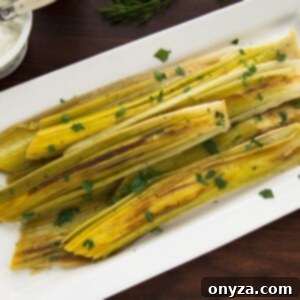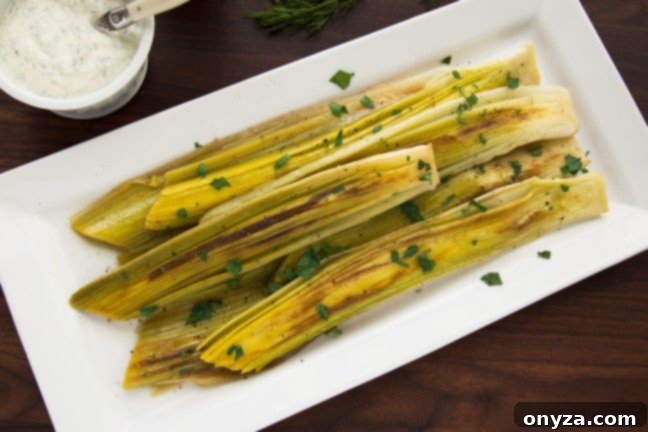Braised Leeks with Zesty Dill-Yogurt Sauce: A Culinary Delight
Discover the delicate sweetness of buttery braised leeks, perfectly complemented by a bright, mildly-tart dill-yogurt sauce. This versatile dish shines as a light vegetarian lunch or an elegant side for broiled fish and various meats.
For those who appreciate the subtle nuances of fresh produce, leeks are often hailed as a true kitchen gem. Their mild, sweet, and slightly oniony flavor offers a sophisticated alternative to their bolder allium cousins, like onions and garlic. Once you’ve experienced the tender, almost melt-in-your-mouth texture of perfectly braised leeks, you’ll find yourself eager to incorporate them into countless culinary creations.
Many years ago, encountering leeks in the market, I admit I mistook them for colossal scallions. However, it wasn’t long before I fell completely in love with their unique character. While they belong to the same esteemed onion family, leeks possess a distinct elegance that sets them apart. They are incredibly versatile, lending a wonderful aromatic depth to dishes ranging from fluffy omelettes and savory quiches to comforting soups and creamy risottos. Yet, it’s when leeks are allowed to step into the spotlight, showcasing their inherent sweetness and delicate texture, that they truly shine.
Throughout their prime season, typically from late fall to early spring, there’s immense joy in preparing dishes where leeks are the undeniable star. Whether grilled and served with a light vinaigrette, transformed into delightful fritters – a personal favorite inspired by Yotam Ottolenghi – or, as we explore here, lovingly braised and paired with a vibrant dill sauce, leeks prove their worth as a star ingredient.
The Inspiration Behind This Flavorful Dish
The primary inspiration for this delightful leek recipe stems from Diana Henry’s exceptional cookbook, A Change of Appetite. Her approach involved steaming leeks and tossing them with olive oil, a dill-yogurt sauce, and a sprinkle of sumac. Having been a long-time enthusiast of sumac – that bright, lemony, and slightly tart spice prevalent in Middle Eastern cuisine – I was instantly captivated by Henry’s elegant combination of flavors. The vibrant tang of sumac beautifully complements the earthy notes of leeks, creating a harmony that is both refreshing and comforting.
Given the chill of winter, a season perfectly suited for the comforting warmth of braised dishes, I decided to adapt this concept. My goal was to marry Henry’s vibrant flavor profile with my preferred method of preparing leeks: slow-braising them in white wine. This technique imparts a remarkable richness and depth to the leeks, transforming them into incredibly tender, buttery morsels. The contrast between this luscious sweetness and the bright, mildly tart notes of the dill-yogurt sauce, enhanced by the subtle citrusy kick of sumac, proved to be an absolute revelation. Instead of simply tossing the leeks in the sauce, we found that dolloping the vibrant sauce on top allowed the inherent sweetness of the braised leeks to truly stand out, creating an exquisite balance of textures and tastes.
Mastering Leek Preparation: The Secret to Success
If there’s one critical piece of advice I can offer about cooking with leeks, it’s this: wash them meticulously! Leeks are celebrated for their beautiful, layered structure, which contributes significantly to their wonderful texture. However, these very layers are also the perfect hiding spots for dirt, sand, and fine grit. A single mouthful of gritty leeks can, unfortunately, ruin an otherwise perfect dish. Trust me, I speak from experience – a memorable batch of risotto in my early twenties taught me this lesson the hard way! But don’t let this deter you; cleaning leeks is remarkably straightforward once you know the proper technique.
Effective Leek Cleaning Techniques
For chopped or thinly sliced leeks, I recommend separating the layers and submerging them in a bowl of cold water. Give them a gentle swish around, allowing them to soak for a few minutes. This action helps dislodge any trapped grit, which will then settle at the bottom of the bowl. Carefully scoop the clean leek pieces from the top of the water, leaving the sediment behind. For an extra measure of confidence, a final rinse in a colander under running water is always a good idea before you start cooking.
When preparing whole leeks, as called for in this particular braised leek recipe where the root end is left intact and the leek is sliced lengthwise, the cleaning process is slightly different but equally effective. After slicing the leek in half, gently fan out its layers. Use the spray nozzle on your kitchen sink to direct a stream of cold water between each layer. Continue rinsing thoroughly until you are absolutely certain that all traces of dirt and sand have been removed. This meticulous approach ensures that every bite of your braised leeks will be nothing short of pure enjoyment.
Serving Suggestions and Perfect Pairings
Braised Leeks with Dill Sauce are wonderfully versatile, making them suitable for various dining occasions. For a light yet satisfying vegetarian lunch, serve them alongside a slice of warm, crusty bread, perfect for soaking up any remaining delicious juices. Alternatively, pair them with a fresh, vibrant spring green salad, lightly dressed with a simple vinaigrette of olive oil and lemon for a truly refreshing meal.
Beyond a standalone lunch, these braised leeks excel as an elegant side dish. They beautifully complement broiled fish, their delicate sweetness and buttery texture providing a lovely counterpoint to flaky white fish. A crisp glass of dry white wine makes for a perfect beverage pairing, enhancing the flavors of both the leeks and the main course.
While this dish is certainly delicious served hot, we often find the leeks are at their absolute best when enjoyed slightly warm or even at room temperature. This allows their inherent sweetness and the nuanced flavors of the braising liquid to truly develop and shine. Don’t be afraid to let them cool down a bit before serving to experience this delightful transformation.
Beyond the Plate: A Delicious Leek Soup
Should you find yourself with any delightful leftovers – which often happens when preparing this dish – a quick and ingenious transformation awaits. A swift trip to the blender or food processor with the remaining braised leeks and a touch of chicken or vegetable broth will yield a wonderfully creamy and flavorful leek soup. It’s an effortless way to extend the enjoyment of this incredible vegetable, offering a second meal that is both comforting and nutritious. Instructions for this simple soup are included in the recipe notes below, ensuring no delicious morsel goes to waste.
With their captivating palette of soft yellows and vibrant greens, leeks bring a much-needed pop of color and freshness to any winter menu, especially on those days when the weather is rather dreary. Embrace the simple elegance of leeks and let this dish be a harbinger of spring, brightening your table and your palate!

Braised Leeks with Dill Sauce
Pairing inspired by Diana Henry, Braising technique from many sources, Sauce adapted from Yotam Ottolenghi
Ingredients
To Braise the Leeks
- 8 small or 4 jumbo leeks , not larger than 1-1/2 inches in diameter
- 1 tablespoon olive oil
- 1 tablespoon unsalted butter
- ½ cup dry white wine
- ½ to ¾ cup low-sodium chicken or vegetable broth
- kosher salt and freshly-ground pepper
To Make the Sauce and Serve
- ¼ cup Greek yogurt
- ¼ cup sour cream
- 1 tablespoon extra-virgin olive oil
- 1-1/2 teaspoons lemon juice *
- ¼ teaspoon kosher salt
- 1 garlic clove , minced
- 1 tablespoon finely chopped Italian parsley leaves
- 2 tablespoons chopped fresh dill
- ground sumac
- freshly-ground pepper
Instructions
To Braise the Leeks
- Trim roots and dark green tops off of leeks, leaving the root end intact so the leeks don’t fall apart when sliced. (Dark green tops can either be discarded or saved for making stock.) Discard any tough outer layers. Slice leeks in half lengthwise and rinse well to remove grit from between the layers. Dry and set aside.
- In a large sauté pan or stove-safe gratin dish, heat butter and olive oil over medium heat until foaming subsides. Add leeks in a single layer, cut side down, and cook until lightly browned, about 3 minutes.** Turn leeks, discarding any papery layers that dislodge, and brown the second side, 2-3 minutes.
- Add wine to the pan, scraping up any browned bits, and simmer for 2 minutes. Add enough broth to come about halfway up the sides of the leeks. Cover with a lid or foil, reduce heat, and gently simmer for about 20 minutes, until leeks are tender when pierced with the tip of a knife. Leeks should be soft, but not mushy.
- Transfer leeks to a platter with a slotted spatula, draining braising liquid. Sprinkle with a pinch or two of salt, some freshly-ground pepper, and let cool. Leeks are best served slightly warm or at room temperature.
Make the Sauce and Serve
- In a small bowl, whisk together Greek yogurt, sour cream, olive oil, lemon juice, kosher salt, garlic, parsley, and dill. Season to taste with additional salt. Refrigerate until ready to serve.***
- When ready to serve, spoon a dollop of Dill Sauce atop each leek and sprinkle with ground Sumac and additional freshly-ground pepper.
Notes
**Jumbo leeks might not fit in your pan in a single layer. In this case, brown the leeks in two batches, adding additional butter and olive oil to the pan between batches as needed. Return all leeks to the pan before deglazing with the wine; it’s okay if they overlap while braising.
***Since braised leeks have a decent moisture content, I like to serve the sauce on the thicker side. If you prefer a thinner sauce, add a little milk or buttermilk to taste.
Tip:
Leftover braised leeks make a delicious Leek Soup! Just place the leeks in a blender or food processor (I use my Vitamix) with a little chicken or vegetable broth. Blend until the soup reaches your desired consistency, adding additional broth as needed. Heat, season with salt and pepper to taste, and serve with a dollop of dill sauce.
Nutrition Estimate
Nutrition information is automatically calculated, so should only be used as an approximation.
Please note that our recipes have been developed using the US Customary measurement system and have not been tested for high altitude/elevation cooking and baking.
